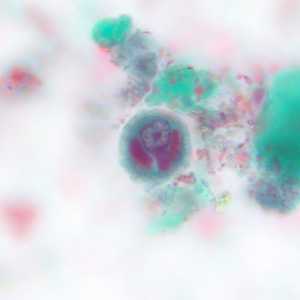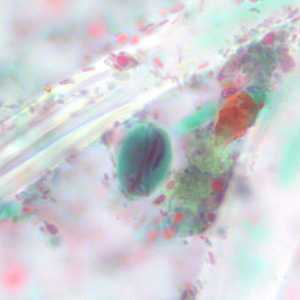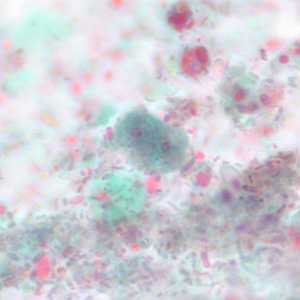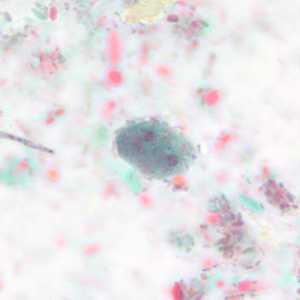
Case #228 - May, 2008
Within a week of returning from a conference in Mexico, a 28-year-old woman presented to her primary care physician with cramps, abdominal pain, gas and diarrhea. A routine Ova and Parasite (O&P) examination was performed on stool specimens. Figures A–F show objects observed on a trichrome-stained slide prepared from the stool. All images were taken at 1000x oil magnification. The objects in Figures A–C measured 12 micrometers. The objects in Figures D and E averaged 10 micrometers. The object in Figure F measured 12 micrometers in diameter. What is your diagnosis? Based on what criteria?

Figure A

Figure B

Figure C

Figure D

Figure E

Figure F
Case Answer
This was a case of giardiasis caused by Giardia duodenalis (Figures B and C). Also observed were Entamoeba polecki (Figures A and B), Dientamoeba fragilis (Figures D and E) and Blastocystis hominis (Figure F). Although the pathogenic status of E. polecki, B. hominis and D. fragilis is currently unresolved, but they should be reported in all routine O&P examinations. The diagnostic features for each organism included:
Giardia duodenalis:
- ovoid cysts within the size range (8-19 micrometers) for the species.
- the presence of median bodies, fibrils and nuclei.
Entamoeba polecki:
- cysts within the size range (9-24 micrometers) for the species.
- the presence of a large, irregular nucleus with a pleomorphic karyosome.
- the presence of numerous irregular, red-staining chromatoid bodies.
Dientamoeba fragilis:
- trophozoites within the size range (5-15 micrometers) for the species.
- a pair of nuclei made up of clusters of karyosomal granules.
Blastocystis hominis:
- a cyst-like form within the size range (5-40 micrometers) for the species.
- a large green-stained central body, surrounded by a thin ring of cytoplasm containing several red-stained inclusion bodies.
More on: Giardiasis; Blastocystis hominis; Dientamoeba fragilis; Entamoeba polecki
Images presented in the monthly case studies are from specimens submitted for diagnosis or archiving. On rare occasions, clinical histories given may be partly fictitious.
DPDx is an education resource designed for health professionals and laboratory scientists. For an overview including prevention and control visit www.cdc.gov/parasites/.
- Page last reviewed: August 24, 2016
- Page last updated: August 24, 2016
- Content source:
- Global Health – Division of Parasitic Diseases and Malaria
- Notice: Linking to a non-federal site does not constitute an endorsement by HHS, CDC or any of its employees of the sponsors or the information and products presented on the site.
- Maintained By:


 ShareCompartir
ShareCompartir